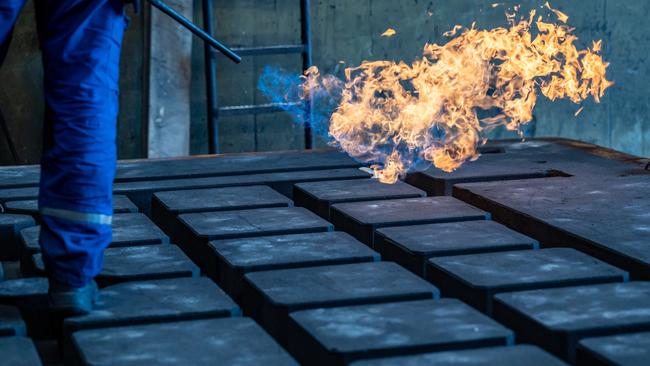Russian gas freeze fires huge price rise; LNG prices set to triple
Russia’s move to cut gas supplies to Europe is set to exacerbate a supply squeeze and spark a further price windfall for Woodside Petroleum and Santos.

Russia’s move to cut gas supplies to Europe is set to exacerbate a supply squeeze and spark a further price windfall for Woodside Petroleum and Santos while Australia’s LNG import ambitions may be pared back by high costs and limited availability of volumes.
The decision by Vladimir Putin to suspend the delivery of gas to Poland and Bulgaria saw natural gas futures in Europe rise as much as 23 per cent and is forecast to buoy LNG prices as the continent competes with Asian buyers for volumes.
LNG prices could more than triple from current Asian spot levels of $US25 per million British thermal units, according to Credit Suisse.
“If Russian gas is shut, LNG prices could go up a further $US50 per mbtu,” Credit Suisse analyst Saul Kavonic said. “This is a very real prospect in the wake of the tragic situation in Europe.”
Woodside would stand to gain an extra $US800m ($1.12bn) in earnings for every $US10mbtu LNG price lift through to the end of 2022, with Santos grabbing an extra $US300m for the same price jump by the end of the year.
Australian households have previously been warned they could be forced to cut their gas use during next year’s winter due to tight markets.
A one-year delay in delivering the nation’s first LNG import plant, owned by billionaire Andrew Forrest, at NSW’s Port Kembla will add to the crimped outlook, with a Victorian official saying on Wednesday the complex situation in Russia and Europe may hinder the timeline for bringing on new gas plants.
“What’s happening in Europe has given some thought to that gas being harder to secure in the short term,” Ralph Griffiths, energy strategy executive director at the Victorian Department of Environment, Land, Water and Planning told a Grattan Institute forum.
The Australian Energy Market Operator said on Wednesday the outlook was finely balanced during peak periods of demand in winter, particularly given depleting sources such as offshore Bass Strait.
“We’ve got to move towards electrification and decarbonisation, but the problem is the rug is being pulled out from us and the gas supply is falling away faster than we can electrify out of it,” AEMO’s gas operations manager Matthew Clemow told the Grattan Institute webinar.
Working out the appropriate level of gas capacity was a broader issue for the industry, he added.
“It’s a very seasonal issue. During the summer and shoulder season, we use 10 petajoules a month for gas in Victoria. But during the winter, we use 25-30 petajoules a month of gas,” Mr Clemow said.
“If you’ve got to electrify the extra 15-20 petajoules of gas that’s used for heating in Victoria, you need to build out that electrical infrastructure to support that but you also need to work out what you’re going to do with that infrastructure during the summer when it’s not needed.”
While Australian exporters are in a powerful position to cash in on the geopolitical uncertainty engulfing Europe, the role of gas within Australia’s domestic energy mix remains increasingly contested given cheap renewable alternatives and growing investor pressure to meet climate change pacts by cutting pollution.
Still, Mr Kavonic said a clamour for the fossil fuel was likely to continue for some time given extreme tensions in Europe despite moves by some nations to diversify away from the energy source.
“In the event more European countries are cut off, it could lead to a scramble for gas, sending European and LNG prices up several fold, well beyond any price records,” he said.
“A cut off of gas could have severe implications for gas pricing globally and for the economies and free market for gas within the EU.”
LNG prices jumped in March to $US50 per mbtu or the equivalent of $US500 a barrel of oil – described as “off the charts” by Woodside Petroleum – as Russian volumes faced being sidelined.
The International Energy Agency has said gas use faces tough competition in many advanced economies although demand is expected to remain high within emerging nations.


To join the conversation, please log in. Don't have an account? Register
Join the conversation, you are commenting as Logout